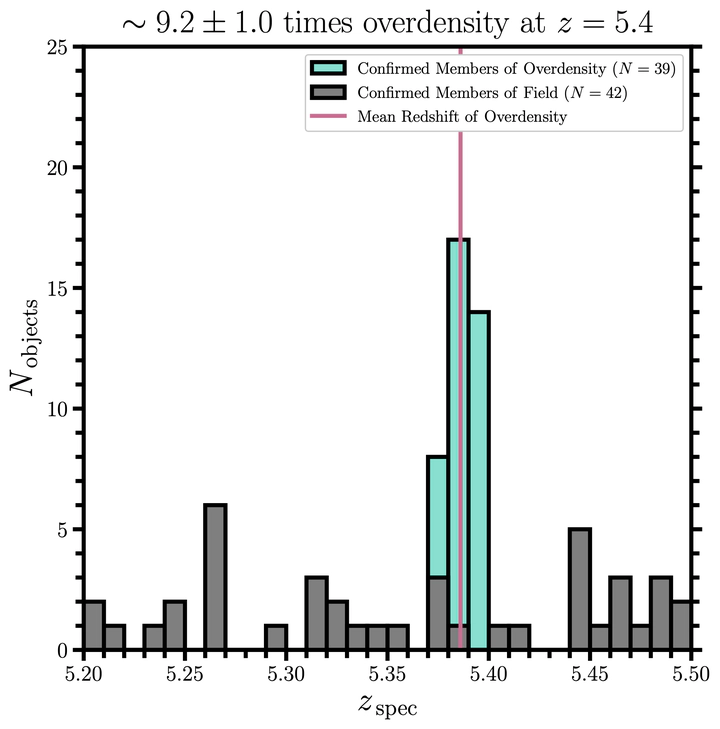The JWST Advanced Deep Extragalactic Survey: Discovery of an Extreme Galaxy Overdensity at z = 5.4 with JWST/NIRCam in GOODS-S
The JWST Advanced Deep Extragalactic Survey: Discovery of an Extreme Galaxy Overdensity at z = 5.4 with JWST/NIRCam in GOODS-S
Feb 13, 2024· ,,,,,,,,,,,,,,,,,,,,,,,,,,,,,,
,,,,,,,,,,,,,,,,,,,,,,,,,,,,,,
Jakob M. Helton
Fengwu Sun
Charity Woodrum
Kevin N. Hainline
Christopher N. A. Willmer
George H. Rieke
Marcia J. Rieke
Sandro Tacchella
Brant Robertson
Benjamin D. Johnson
Stacey Alberts
Daniel J. Eisenstein
Ryan Hausen
Nina R. Bonaventura
Andrew Bunker
Stephane Charlot
Mirko Curti
Emma Curtis-Lake
Tobias J. Looser
Roberto Maiolino
Chris Willott
Joris Witstok
Kristan Boyett
Zuyi Chen
Eiichi Egami
Ryan Endsley
Raphael E. Hviding
Daniel T. Jaffe
Zhiyuan Ji
Jianwei Lyu
Lester Sandles
 Figure 1 from Helton et al. (2024, ApJ, 962, 124).
Figure 1 from Helton et al. (2024, ApJ, 962, 124).Abstract
We report the discovery of an extreme galaxy overdensity at $z = 5.4$
in the GOODS-S field using James Webb Space Telescope (JWST)/NIRCam imaging from JADES and JEMS alongside JWST/NIRCam wide-field slitless spectroscopy from FRESCO. We identified potential members of the overdensity using Hubble Space Telescope+JWST photometry spanning $\lambda = 0.4-5.0\ \mu\mathrm{m}$
. These data provide accurate and well-constrained photometric redshifts down to $m \approx 29-30\ \mathrm{mag}$
. We subsequently confirmed $N = 81$
galaxies at $5.2 < z < 5.5$
using JWST slitless spectroscopy over $\lambda = 3.9-5.0\ \mu\mathrm{m}$
through a targeted line search for $\mathrm{H}\alpha$
around the best-fit photometric redshift. We verified that $N = 42$
of these galaxies reside in the field, while $N = 39$
galaxies reside in a density around $\sim 10$
times that of a random volume. Stellar populations for these galaxies were inferred from the photometry and used to construct the star-forming main sequence, where protocluster members appeared more massive and exhibited earlier star formation (and thus older stellar populations) when compared to their field galaxy counterparts. We estimate the total halo mass of this large-scale structure to be $12.6 \leq \mathrm{log}_{10}(M_{\mathrm{halo}}/M_{\odot}) \leq 12.8$
using an empirical stellar mass to halo mass relation, which is likely an underestimate as a result of incompleteness. Our discovery demonstrates the power of JWST at constraining dark matter halo assembly and galaxy formation at very early cosmic times.
Type
Publication
The Astrophysical Journal, Volume 962, Issue 2, id.124, 17 pages
High-Redshift Galaxies
High-Redshift Galaxy Clusters
Galaxy Formation
Galaxy Evolution
Early Universe
Related
- JWST NIRCam + NIRSpec: interstellar medium and stellar populations of young galaxies with rising star formation and evolving gas reservoirs
- JADES: Rest-frame UV-to-NIR Size Evolution of Massive Quiescent Galaxies from Redshift z = 5 to z = 0.5
- The JADES Origins Field: A New JWST Deep Field in the JADES Second NIRCam Data Release
- JADES: deep spectroscopy of a low-mass galaxy at redshift 2.3 quenched by environment
- Overview of the JWST Advanced Deep Extragalactic Survey (JADES)